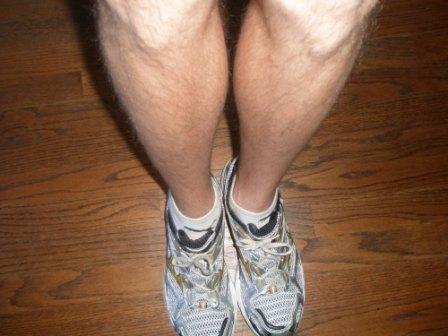Shin Splints
Tweet
One of the toughest injuries to deal with as a runner are shin splints. Mainly because they are caused by too much running and the only proven way to fully recover is not to run. So pretty much you get injured doing something you love in excess; and then the only way to heal from that injury is to abstain from that activity. See, abstinence can be a good thing.

Shin splints are caused by the repeated stress on the shin bone (or tibia for you MD types) and the tissue that connects the muscle to the shin. Shin splints may occur for a couple of reasons. Perhaps you changed to a new running shoe that doesn’t have as much support as you are used to. Or you may have started running on different surfaces, like running trails. Most likely though, you have just been pushing yourself too hard. Running more than your body is used to and causing too much stress on your tibia. Stop being a stress monkey and just let your body relax.
The first signs that you may have shin splints are that you feel pain on the front/lower part of your leg and may have mild swelling. The pain starts as a dull ache or soreness when you begin running. The more you run, you start to develop a more sharper pain throughout your work out. If you keep pushing through this pain it can lead to a sharp pain in your shins even when you are done running. If you have pushed yourself this far, don’t be ashamed, we all love to run, but you may need to see a doctor to get an X-ray and rule out a possible stress fracture. Running is cool. Stress fractures? Not so much.
But this won’t happen to you right? You’ve been listening to your heart. So when you start feeling the first signs of shin splints what can you do? The best thing is rest. You know you’re good at doing that. If you want to keep yourself active then try other low impact activities like swimming or biking. If you love running too much and don’t want running to feel like you abandoned her, then try running on softer surfaces such as dirt or grass. Also, try to avoid hills and reduce your distance and duration. Don’t worry, running will understand.
But wait, you can do more! Stretches can help shin splints. Elevate your legs so they are parallel to the ground and point your toes forward to stretch these muscles. If you have swelling and pain, ice yourself. Try to ice 10-20 minutes 3 times a day; or as much as you have time for. For optimal results start calling yourself Iceman by referring to yourself in the 3rd person. All of that too much work for you? Then improve your shin splints when you sleep. Elevate your lower legs with a pillow or something else when sleeping at night. See, healing shin splints is so easy.
You may be a serious runner but shin splints are just as serious as you are. Stop being cocky and give them the respect that they deserve. Respect-da.
Tags: shin splints


[…] can aggravate these types of injuries as well as create injuries on their own like shin splints. Shin splints are caused by the repeated stress on the shin bone, often as a result from running on concrete. […]